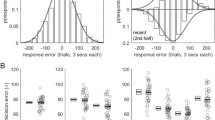Abstract
Two theoretical approaches to the representation of Time and Location Markers in Memory were contrasted. According to predictions derived from one approach, the amount of forgetting will be the same for two-proposition sentences and sentences with a single proposition and a Time or a Location marker. According to the other approach, the amount of forgetting will be the same for one-proposition sentences and sentences with a Time or a Location Marker. Propositional structure and the level of within-sentence associations were orthogonally varied to create eight within-subject experimental conditions. Ninety subjects studied 40 sentences and were required to recall then. Four dependent variables were used: number of sentences completely recalled, number of sentences partially recalled, number of sentences where information was lost from within the proposition, and number of sentences where a complete proposition was lost. The results suggest that Time and Location markers are represented in memory as arguments in a proposition rather than as separate propositions. Level of associations within the sentence seems to have a different effect when the sentence is composed of one or two propositions. The results also suggest that there may be differences between the representations of Time and Location markers.
Similar content being viewed by others
References
Anderson, J. R.Language, memory, and thought. Hillsdale, New Jersey: Erlbaum, 1976.
Anderson, J. R., & Bower, G. H.Human associative memory. Washington, D.C.: Winston, 1974.
Kintsch, W.The representation of meaning in memory, Hillsdale, New Jersey: Erlbaum, 1974.
Norman, D. A., Rumelhart, P. E., & LNR Research Group.Exploration in cognition. San Francisco: Freeman, 1975.
Paivio, A.Imagery and verbal processes. New York: Holt, Rinehart & Winston, 1971.
Peleg, Z. R. Case relations vs. associations as sources of constructive processes in memory for sentences.American Journal of Psychology, 1978,91, 619–630.
Thorndike, E. L., & Lorge, I.The teacher's word book of 30,000 words. New York: Colubia University Press, 1944.
Author information
Authors and Affiliations
Rights and permissions
About this article
Cite this article
Peleg, Z.R. The representation of time and location in memory for sentences. J Psycholinguist Res 11, 169–182 (1982). https://doi.org/10.1007/BF01068219
Accepted:
Issue Date:
DOI: https://doi.org/10.1007/BF01068219




